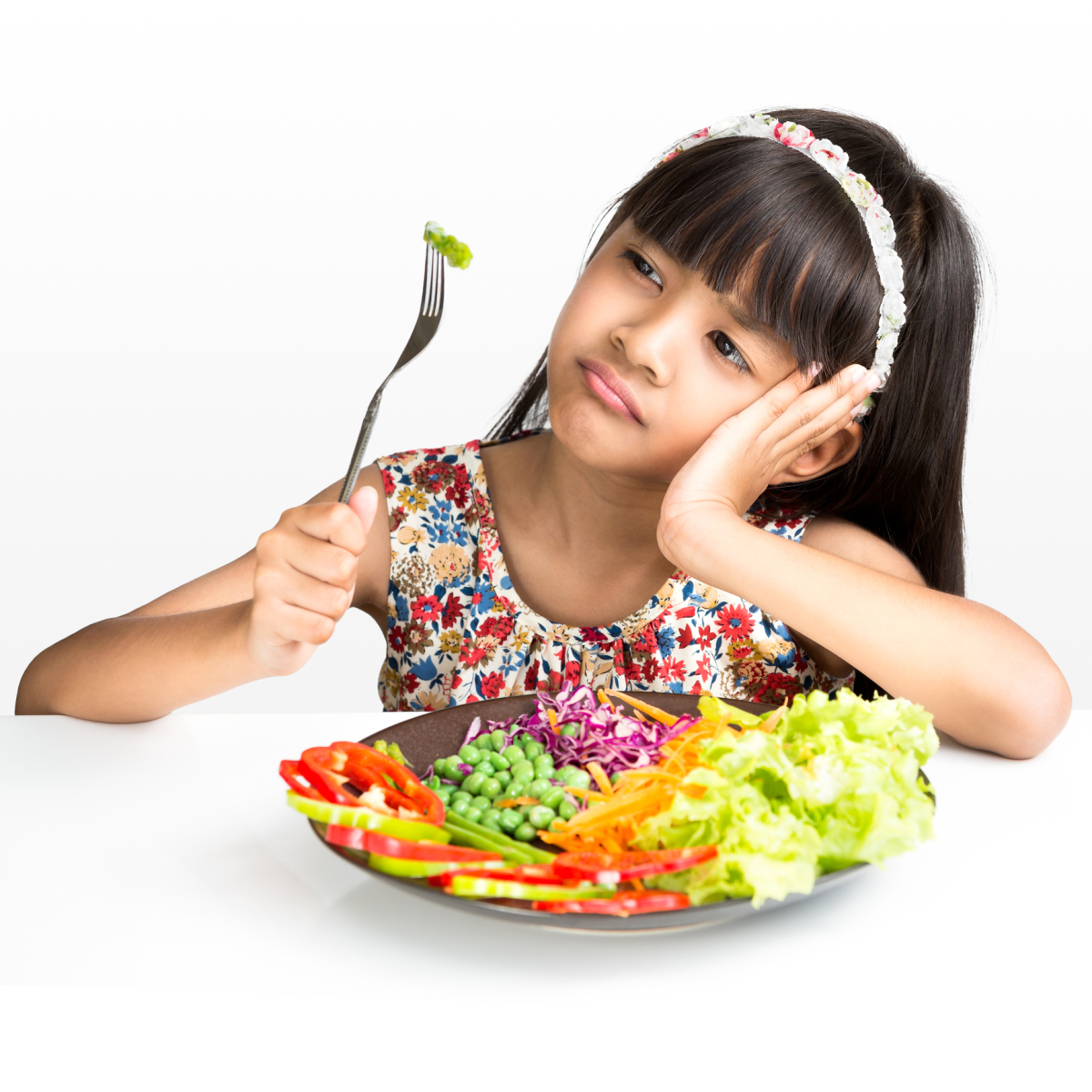Vegetables play an important role in supporting your child’s growth and long-term health. Eating a variety of vegetables early in life can help your child develop a healthy gut microbiome that supports digestion and can promote lifelong well-being. Since eating habits formed in childhood often continue into adulthood, encouraging vegetable consumption early can help your child experience the lifelong benefits of a healthy, balanced diet. As your child grows, diets rich in vegetables can also lower the risk of obesity and help prevent many chronic diseases, such as heart problems and certain types of cancer (Holley et al., 2017). More specifically, raw and leafy green vegetables may offer protection against cardiac events, such as heart attacks, later in life (Holley et al., 2017). Review the United States Department of Agriculture (USDA) daily dietary recommendations for vegetables (Table 1), and try some of the strategies below to help your child develop a fondness for vegetables that can contribute to his or her health now and as your child grows.
Table 1
USDA General Daily Vegetable Recommendations for Children by Age
Toddlers – 12 to 24 months
- 2/3 to 1 cup
Children – 2 to 3 years
- 1 to 1 1/2 cups
Children – 4 to 8 years
- 1 1/2 to 2 1/2 cups
Girls – 9 to 13 years
- 1 1/2 to 3 cups
Girls – 14 to 18 years
- 2 1/2 to 3 cups
Boys – 9 to 13 years
- 2 to 3 1/2 cups
Boys – 14 to 18 years
- 2 1/2 to 4 cups
Positive Strategies to Try with Your Child
Parental and Peer Modeling. Children are more likely to eat vegetables when they see parents, siblings, and peers enjoying them. Family meals provide an opportunity to model healthy eating by including vegetables in everyday dishes like stir-fries, pastas, and salads. When children see others filling their plates with vegetables, they are more likely to want to do the same.
Repeated Exposure. Offering vegetables regularly and in different ways helps children become more comfortable with seeing, smelling, and touching them. Children often reject some vegetables at first, and this is normal. However, repeated exposure and gentle encouragement can lead to acceptance. Some children may need to try a new vegetable up to 12 to 17 times (or more) before they begin to like it (Fjeldberg, 2022).
Pair Vegetables with Familiar Foods. Offering vegetables with familiar, preferred dips (e.g., yogurt, ranch dressing, hummus, ketchup) can help children, especially those sensitive to bitter tastes, try more vegetables, like green, cruciferous vegetables such as broccoli and Brussels sprouts.
Adapt Mealtime Routines. At mealtimes, try serving vegetables first when children tend to be the hungriest. You can also offer larger portion sizes of vegetables, or serve several different vegetable options and let your child choose which ones to try and eat to give them a sense of control. In addition, vegetables make great snacks! If you stock up on vegetables for snacks and limit less nutritious snacks in your home, children may be more likely to choose vegetables when they are hungry.
Vary Your Vegetables. Providing a variety of vegetables, and in different forms, such as raw or cooked, can help ensure children consume many different vitamins and minerals. You may want to try blending vegetables into smoothies, soups, and sauces to introduce new flavors and textures and increase your child’s daily intake, but do not use this method to trick your child into eating more vegetables.
Make Vegetables Accessible. When vegetables are washed, cut, and placed within easy reach, such as on the dinner table, in lunchboxes, or as ready-to-eat snacks in the fridge, children may be more likely to grab them when they are hungry or looking for a quick snack. Make vegetables visible, available, and effortless to eat to encourage your child to try and enjoy them regularly.
Include Your Child. Involve children in choosing vegetables at the store, growing them at home, and helping prepare them for meals. These practices can spark curiosity and increase your child’s interest in trying new vegetables.
Use Non-Food Rewards. Pairing repeated exposure to vegetables with small rewards, like stickers, can encourage children to try and eventually enjoy vegetables they previously disliked.
Make Eating Vegetables Fun! When eating vegetables feels playful and interactive, children may be more likely to try a new vegetable and develop positive associations with eating it. Try activities, such as a taste-testing game or helping your child decorate his or her plate with creative vegetable faces to add some fun and whimsy to meal and snack time.
Putting Positive Strategies into Practice
As a parent, your responsibility is to provide healthy and nutritious food for your child. Give your child the responsibilities of choosing how much food to eat and whether to eat. When parents or caregivers use certain methods to get their child to eat, these practices can hinder a child’s desire to want to try new foods and develop a genuine liking for vegetables. The chart below offers helpful tips on what to do—and what to limit or avoid—when encouraging your child to try new vegetables.
Do…
- Offer gentle encouragement and repeated exposure to help children develop positive attitudes towards trying new foods.
- Calmly remove uneaten food from your child’s plate after a reasonable time during mealtimes (e.g., 20 – 30 minutes), and continue offering vegetables at future meals without pressure.
- Use positive reinforcement and provide non-food rewards, like stickers, to encourage children to try new vegetables or vegetables they previously disliked.
- Offer a variety of vegetables and celebrate small steps toward trying new vegetables without applying labels.
- Serve vegetables in their natural form as much as possible so children can become familiar with their tastes and textures.
Avoid…
- Forcing or pressuring children to eat vegetables as this might create negative feelings about those foods.
- Disciplining or scolding children for not eating vegetables as this could create negative associations with food and increase mealtime stress.
- Using dessert or other treats as a reward for eating vegetables as this can make less nutritious foods seem more desirable and frame vegetables as a food that is unpleasant. Using bribes can reduce a child’s interest in healthy foods.
- Calling a child a “picky eater” because doing so can reinforce the behavior and make the child feel stuck in that identity.
- Hiding vegetables in other foods may help your child consume more vegetables in the short term; however, this practice does not teach children to recognize or enjoy vegetables.
Table 2
USDA Cup of Vegetable Table
Each amount listed is what constitutes a serving of vegetables.
Dark-Green Vegetables
- Broccoli – 1 cup, chopped or florets, fresh or frozen
- Bitter melon leaves, chrysanthemum leaves, escarole, taro leaves, turnip greens – 1 cup, cooked
- Beet greens, bok choy, broccoli rabe (rapini), chard, collards (collard greens), cress, dandelion greens, kale, mustard greens, spinach, Swiss chard, watercress – 1 cup, cooked or 2 cups, fresh, canned, or frozen
- Raw leafy greens: Arugula, basil, cilantro, dark green leafy lettuce, endive, escarole, mixed greens, mesclun, romaine – 2 cups, fresh
Red and Orange Vegetables
- Carrots – 2 medium carrots or 1 cup, slices or chopped, fresh, cooked, or frozen or 1 cup baby carrots
- Pimento/Pimiento – 3 whole or 1 cup
- Pumpkin, calabaza – 1 cup, mashed, cooked
- Red and orange bell peppers – 1 large bell pepper or 1 cup, chopped, fresh, or frozen
- Red chili peppers – ¾ cup
- Sweet potato – 1 large sweet potato, baked or 1 cup, sliced or mashed, cooked
- Tomatoes – 1 large tomato or 2 small tomatoes or 1 cup, chopped or sliced, fresh, canned, or cooked
- 100% vegetable juice – 1 cup
- Winter squash (acorn, butternut, kabocha) – 1 cup cubed, cooked, fresh, or frozen
Beans, Peas, and Lentils
- Dry beans and peas and lentils (such as bayo, black, brown, fava, garbanzo, kidney, lima, mung, navy, pigeon, pink, pinto, soy, or white beans, or black-eyed peas or split peas, and red, brown, and green lentils) – 1 cup, whole or mashed, cooked
Starchy Vegetables
- Breadfruit – 1½ cups, cooked
- Cassava – ¾ cup, cooked
- Corn, yellow or white – 1 large ear of corn or 1 cup corn kernels, fresh or frozen
- Green peas – 1 cup, fresh or frozen
- Hominy – 1 cup, cooked
- Plantains – ¾ cup, cooked
- White potatoes – 1 medium white potato, boiled or baked or 1 cup, diced, mashed, fresh, or frozen
Other Vegetables
- Asparagus – 1 cup
- Avocado – 1 avocado
- Bamboo shoots – 1 cup
- Bean sprouts – 1 cup, cooked
- Cabbage, green, red, napa, savoy – 1 cup, chopped or shredded, raw or cooked
- Cactus pads (nopales) – 5 pads or 1 cup, sliced
- Cauliflower – 1 cup, pieces or florets, raw or cooked, fresh or frozen
- Celery – 1 cup, diced or sliced, raw or cooked or 2 large stalks (11″ to 12″ long)
- Cucumbers – 1 cup, raw, sliced or chopped
- Green or wax beans – 1 cup, raw or cooked, fresh or frozen
- Green bell peppers – 1 large bell pepper or 1 cup, chopped, raw or cooked, fresh or frozen
- Lettuce, iceberg or head – 2 cups, raw, shredded, or chopped
- Mushrooms – 1 cup, raw or cooked
- Okra – 1 cup, cooked
- Onions – 1 cup, chopped, raw or cooked
- Summer squash or zucchini – 1 cup, cooked, sliced or diced
Additional Resources
Cooking to Thrive: https://thrive.psu.edu/wp-content/uploads/2025/06/thrive_cooking-to-thrive_20250630.pdf
MyPlate.gov Vegetable Tip Sheet: https://myplate-prod.azureedge.us/sites/default/files/2024-06/TipSheet-3-Vary-Your-Vegetables.pdf
References
Beals, E., Deierlein, A., & Katzow, M. (2023). Clinical interventions to increase vegetable intake in children. Current Opinion in Pediatrics, 35(1), 138-146. http://dx.doi.org/10.1097/MOP.0000000000001203
Fjeldberg, G. (2022, September 21). Raising healthy eaters: Should kids clean their plate? Mayo Clinic Health System. https://www.mayoclinichealthsystem.org/hometown-health/speaking-of-health/raising-healthy-eaters-should-kids-clean-their-plate
Holley, C.E., Farrow, C., & Haycraft, E. (2017). A systematic review of methods for increasing vegetable consumption in early childhood. Current Nutrition Reports, 6, 157–170. https://doi.org/10.1007/s13668-017-0202-1
Lomte, T. S. (2025, March 18). Eating a variety of plants helps infants build a stronger gut microbiome. News-Medical.Net. https://www.news-medical.net/news/20250318/Eating-a-variety-of-plants-helps-infants-build-a-stronger-gut-microbiome.aspx
RaisingChildren.net.au. (n.d.). Vegetables: Tips to encourage children to eat more. https://raisingchildren.net.au/toddlers/nutrition-fitness/healthy-eating-habits/vegetables
Stanford Medicine Children’s Health. (n.d.). 5 ways to boost your child’s gut health. https://www.stanfordchildrens.org/en/topic/default?id=5-ways-to-boost-your-childs-gut-health-197-29161
United States Department of Agriculture. (n.d.). Vegetables. https://www.myplate.gov/eat-healthy/vegetables




